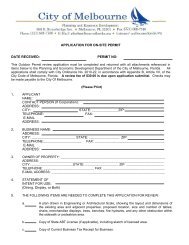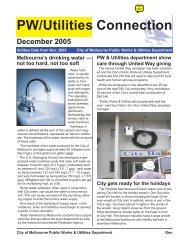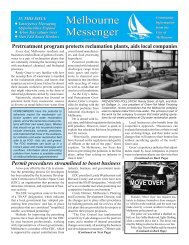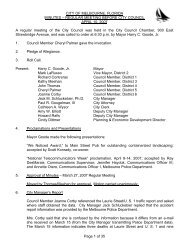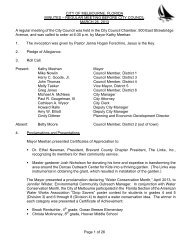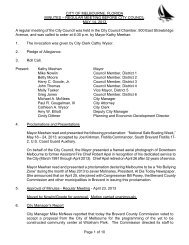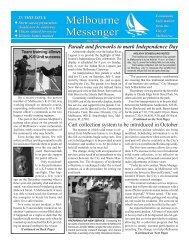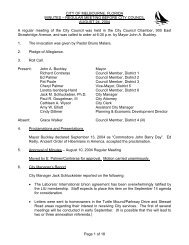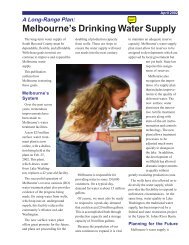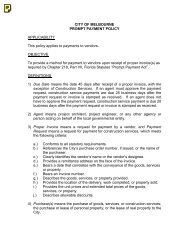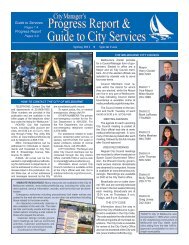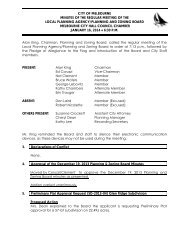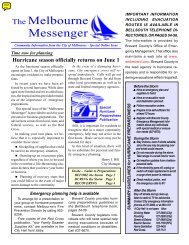Historic Guidelines - City of Melbourne, Florida
Historic Guidelines - City of Melbourne, Florida
Historic Guidelines - City of Melbourne, Florida
Create successful ePaper yourself
Turn your PDF publications into a flip-book with our unique Google optimized e-Paper software.
General Terms Defined<br />
Rehabilitation - The act or process <strong>of</strong> returning a property to a state <strong>of</strong> utility through repair or<br />
alteration which makes possible an efficient contemporary use, while preserving those portions or<br />
features <strong>of</strong> the property which are significant to its historical, architectural, and cultural values.<br />
Relocation – When a building is moved, intact, to a new site.<br />
Renovation - Modernization <strong>of</strong> an old or historic building that may produce inappropriate alterations or<br />
elimination <strong>of</strong> important features or details.<br />
Repairable – Structures or building features that can be fixed or restored without creating an imminent<br />
hazard to public safety. For the purpose <strong>of</strong> this document, it is assumed that most damage, including<br />
partial termite or partial fire damage, can be repaired. It should be the applicant’s responsibility to<br />
demonstrate otherwise.<br />
Resource - Sites, buildings, structures, objects, districts, and areas, public or private, single or in<br />
combination.<br />
Restoration - Act or process <strong>of</strong> accurately depicting the form, features, and character <strong>of</strong> a property as<br />
it appeared at a particular period <strong>of</strong> time by means <strong>of</strong> the removal <strong>of</strong> features from other periods in its<br />
history and reconstruction <strong>of</strong> missing features from the restoration period. The limited and sensitive<br />
upgrading <strong>of</strong> mechanical, electrical, and plumbing systems and other code-required work to make<br />
properties functional is appropriate within a restoration project.<br />
Revitalization - The imparting <strong>of</strong> new economic and community life in an existing neighborhood, area,<br />
or business district while at the same time preserving the original building stock and historic character.<br />
Right-<strong>of</strong>-Way – The strip <strong>of</strong> land owned or controlled by the <strong>City</strong> or another governmental agency<br />
over which the public has a right <strong>of</strong> passage, including the streets, parkways, medians, sidewalks and<br />
driveways constructed thereon. For the purpose <strong>of</strong> this section “right-<strong>of</strong>-way” should exclude alleys.<br />
Secretary <strong>of</strong> the Interior’s Standards for Rehabilitation - A set <strong>of</strong> guidelines produced by the United<br />
States Department <strong>of</strong> the Interior that establish pr<strong>of</strong>essional standards for the sensitive rehabilitation<br />
<strong>of</strong> an historic property. The ten (10) standards generally address design issues which include: character<br />
defining features; changes which have occurred over the course <strong>of</strong> the property’s history; desirable<br />
approaches to the repair <strong>of</strong> damaged features; appropriate cleaning methods, and design approaches<br />
to new construction.<br />
DRAFT<br />
Setting - The physical environment <strong>of</strong> a historic property. It involves how, not just where, the property<br />
is situated and its relationship to surrounding features and open space.<br />
Site - The location <strong>of</strong> a significant event, activity, building, structure, or archaeological resource.<br />
Site Improvement - Includes, but is not limited to, walls, fences, signs, sidewalks, planters, driveways,<br />
paving and exterior lighting.<br />
Streetscape - The distinguishing and pictorial character <strong>of</strong> a particular street as created by its width,<br />
degree <strong>of</strong> curvature and paving materials, design <strong>of</strong> the street furniture, and forms <strong>of</strong> surrounding<br />
buildings.<br />
APPENDIX<br />
Structure - As distinguished from buildings, the term structure indicates those functional constructions<br />
made usually for purposes other than creating human shelter.<br />
Visual Compatibility Criteria - Factors dealing with height, proportion, rhythms, materials and color,<br />
which the <strong>Historic</strong> Preservation Board uses to determine whether new construction and renovation <strong>of</strong><br />
existing buildings is visually compatible with the <strong>Historic</strong> District.<br />
46



